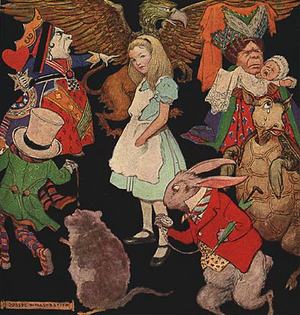For years literary critics and medical scholars alike have likened the scenes of Alice’s Adventures in Wonderland and Through the Looking Glass to those of drug related hallucinations. The images of Alice, both shrinking and growing, have amused, intrigued, and even scared generations of readers. As a result, rumors have accused Lewis Carroll, whose real name is Charles Lutwidge Dodgson, of drug addiction. While we know that Carroll did use Laudanum, an opiate that was a common additive in many medications of the day, there is no evidence to support the theory that he was an addict. Why then, was he able to create such an outlandish world? Was he simply gifted with a remarkable imagination, or was he inspired by a medical condition?
It has been well documented that in his lifetime Lewis Carroll suffered from at least one migraine. The powerful headaches can be devastating in themselves; however migraines have other side effects. While these other side effects aren’t usually depicted as painful, they can be just as bothersome and are usually seen as pre-headache warning signs. They are known as auras. Auras can affect one or all of the senses, and a majority of migraine sufferers report experiencing at least one form during an episode. While there is no documented proof that Carroll ever experienced any auras, it might not be a coincidence that a rare form of aura causes the sufferer to perceive the same experiences felt by his character Alice. Did Lewis Carroll secretly suffer from a rare form of aura which has subsequently been named after his most famous book?
First described by C W Lippman in a 1952 medical journal, the affliction went unnamed until 1955 when English psychiatrist John Todd dubbed it Alice in Wonderland Syndrome (AIWS). Todd also referred to it as Lilliputian hallucination, so called because of the tiny people of Lilliput described in Gulliver’s Travels. However, the scientific name is Micropsia. Originally thought to have been strictly a psychological disorder, we now know that there are several causes. Although AIWS can be brought on by epilepsy, infectious mononucleosis, schizophrenia, anorexia, and some psychoactive drugs, this rare syndrome most often occurs in conjunction with migraines. It is most prevalent in children aged five to ten, and in most cases they outgrow it during their teens. The disorder generally manifests itself in individuals with a family history of migraines, and the episodes usually last between ten and sixty minutes.
There are several different symptoms of AIWS, and all of them have one thing in common: distorted perception. The most common symptom (the reason Alice in Wonderland is often referenced) is distorted body image. The sufferer can feel like their entire body or certain parts of it have grown or shrank. Sufferers can also see other people or objects as being larger or smaller than they really are. At times objects will seemingly grow or shrink right in front of their eyes. Other visual distortions can include distance. For example: hallways can seem much longer than they are, or the ground can seem higher than it really is. In Lippman’s 1952 report, he tells of a patient who experienced a “tweedledee” feeling, meaning that she felt short and fat while walking. Other symptoms of AIWS include time, touch, and sound distortions.
Cases of AIWS are extremely rare (most physicians aren’t even aware that it exists), and they almost always occur as a side effect of something else. Because of this, there are no treatments specifically designated for it. However, in some cases, treating the underlying causes has been known to decrease the occurrence of episodes. Unfortunately, many patients have been known to continue experiencing AIWS even after the causes have disappeared.
We will never know for certain whether the images of “a grin without a cat,” smoking caterpillars, extremely long corridors, and size shifting girls were products of Carroll’s imagination or merely experiences brought on by a medical disorder. There is no proof that he did or didn’t suffer from AIWS just like there is no evidence to serve the theory that he was an avid drug user. However, this mystery serves to deepen the myth of the man and renders the reading of his works all the more fascinating.



